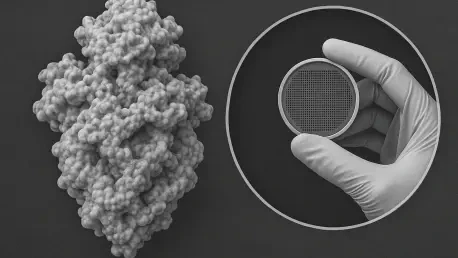What happens when the building blocks of life face destruction before they can fulfill their purpose, and how do cells protect these vital components during such a delicate process? Inside every cell, a precise mechanism unfolds where proteins, essential for everything from immunity to growth, are crafted with meticulous care. Yet, this process teeters on the edge of chaos, vulnerable to errors that can trigger devastating diseases like cancer or diabetes. A groundbreaking discovery using cryogenic electron microscopy, known as cryo-EM, has now pulled back the curtain on how cells deploy molecular shields to protect these vital proteins during synthesis. This revelation promises to reshape the understanding of cellular health and open new doors to life-changing treatments.
Why Protecting Proteins Is a Matter of Life and Death
At the core of cellular function lies protein synthesis, a process that dictates how organisms grow, heal, and defend against threats. When proteins are improperly modified during creation, particularly through a step called glycosylation where sugar molecules are added, the consequences can be dire. Conditions such as metabolic disorders or bone fragility often stem from these missteps, affecting millions globally. With around 7,000 of the human genome’s 20,000 proteins processed in the endoplasmic reticulum (ER), a cellular hub for protein maturation, safeguarding this pathway is not just a scientific puzzle—it’s a critical health priority.
The stakes become even clearer when considering the ripple effects of failure in this system. A single error in protein modification can cascade into systemic issues, disrupting everything from blood sugar regulation to skeletal strength. This urgency drives researchers to uncover the mechanisms that prevent such breakdowns, seeking answers that could alleviate suffering for countless individuals battling related illnesses.
Zooming in on GRP94: A Protein Under Siege
Deep within the ER, a protein called GRP94 plays a pivotal role by helping others fold into their functional shapes. However, GRP94 itself faces a threat during synthesis: hyperglycosylation, where excessive sugar molecules tag it for destruction before it can serve its purpose. Cryo-EM has captured stunning images of this vulnerable state, revealing how GRP94 risks being sidelined by the cell’s own sugar-adding machinery, known as the oligosaccharyl transferase complex (OST).
This high-resolution glimpse shows a battle for survival at the molecular level. Without intervention, the loss of GRP94 disrupts critical cellular tasks, contributing to conditions like immune deficiencies or tissue damage. The imagery provided by cryo-EM serves as a window into this hidden conflict, highlighting why protection at this stage is non-negotiable for maintaining cellular balance.
The Protective Trio: Allies Against Hyperglycosylation
The story takes a remarkable turn with the discovery of GRP94’s guardians—two proteins, CCDC134 and FKBP11, which form a protective complex around it. Cryo-EM snapshots reveal how these chaperones physically block OST from over-modifying GRP94, ensuring its stability during synthesis. This intricate teamwork represents a sophisticated cellular strategy, one that dictates whether a protein thrives or perishes.
Disruptions in this defense mechanism carry grave implications. Mutations in CCDC134, for instance, dismantle the shield, leaving GRP94 exposed to hyperglycosylation and linking directly to disorders like osteogenesis imperfecta, characterized by brittle bones. These findings underscore how specific molecular interactions can have profound effects on human health, turning microscopic events into tangible outcomes.
Behind the Lens: Scientists Reflect on a Rare Breakthrough
Robert Keenan from the University of Chicago, whose lab led this pioneering effort alongside Rajat Rohatgi’s team at Stanford University, called the capture of GRP94 mid-synthesis “a moment of pure chance after years of pursuit.” This candid reflection highlights the tenacity behind the discovery, with cryo-EM providing a rare view of a fleeting cellular event. Rohatgi’s complementary research on GRP94’s disease links added depth, framing the structural findings within a broader medical context.
Their combined insights, shared through rigorous publications, emphasize the transformative potential of structural biology. Keenan remarked, “Witnessing this protective complex in action challenges long-held assumptions about protein regulation.” Such personal accounts from the forefront of science bring a human dimension to the complex world of molecular research, illustrating the passion driving these advancements.
Charting New Paths: Turning Discovery into Healing
How can this molecular shield translate into real-world impact? The insights from cryo-EM pave the way for innovative strategies in disease treatment, starting with a shift in focus from GRP94 itself to its protectors, CCDC134 and FKBP11. Past attempts to target GRP94 directly faltered due to unintended effects on similar proteins, but these chaperones offer a more precise therapeutic entry point for conditions like diabetes and cancer.
Beyond drug design, the research suggests developing diagnostic tools to spot CCDC134 mutations early, enabling timely interventions for disorders such as osteogenesis imperfecta. Additionally, structural data from cryo-EM could inspire compounds that mimic or boost the protective complex, stabilizing GRP94 in disease states. These approaches form a blueprint for bridging laboratory breakthroughs with clinical solutions, potentially transforming patient care over the coming years from 2025 onward.
Reflecting on a Milestone in Cellular Science
Looking back, the journey to uncover how cells shield proteins like GRP94 during synthesis marked a defining moment in structural biology. The vivid images captured through cryo-EM illuminated a once-invisible process, revealing the intricate dance of molecular guardians that preserve cellular harmony. This achievement stood as a testament to the power of persistence and collaboration in science, blending expertise across institutions to tackle profound questions.
As the scientific community moved forward, the next steps became clear: refining therapeutic targets like CCDC134 and FKBP11 to craft precise treatments, expanding diagnostic capabilities to catch vulnerabilities early, and leveraging structural insights for drug innovation. These efforts promised to turn a microscopic discovery into macroscopic hope, offering new strategies to combat diseases that had long challenged medicine. The path ahead invited researchers and clinicians alike to build on this foundation, ensuring that the guardians of protein synthesis continued to inspire solutions for generations.









